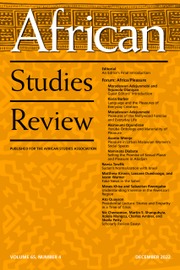In this first volume of a two-volume set, Nat Rubner offers an extraordinarily well-documented and compelling account of the political, intellectual, and cultural foundations of the African Charter on Human and People’s Rights (ACHPR). Adopted in 1981 by the Organization of African Unity (OAU), the Charter went into effect in 1986. It has been widely heralded as one of the three charter-based regional human rights systems (with Europe and the Americas being the other two), as well as the first non-Western declaration of human rights.
The reader may be surprised to note that Volume One includes no discussion of the ACHPR itself. Rather, it examines the foundations of what became the African human rights system, challenging the “pervasive, pre-emptive presumption” that the ACHPR is located in an “inexorable universal human rights tradition … and an aspiration to emulate the universal paradigm” of the Universal Declaration of Human Rights (UDHR) (4). Much to the contrary, Rubner contends that the ACHPR should be understood not as a clear corollary to the UDHR, but as a broad “reproach to the concept of universal human rights” (11).
To make his case, Rubner probes multiple strands of African “revanchism,” which he defines as the determination to achieve the “recovery and assertation of an identity, heritage and culture hitherto denied by Western universalism” (9). In this way, he contextualizes the ACHPR in the political and cultural ideas of postcolonial Africa—including the principles and politics surrounding the founding of the OAU as well as African ideas about human rights both domestically and at the United Nations. The argument is organized around three key themes: (a) the Atlantic Charter and the postwar international settlement; (b) the emergence of the OAU; and (c) the predicament of Black disalienation in debates about religion, literature, négritude, education, language, and African socialism.
Human rights scholars will be fascinated by the book’s detailed history of African constitution-writing. On the surface, it is striking that most constitutions in newly independent Africa contained references to the UDHR, the Rights of Man or included a Bill of Rights. But Rubner’s close examination of drafting processes suggests that these provisions did not reflect substantive commitments to human rights, as is often argued, but rather were the products of specific historical colonial relationships with Britain, France, and (later) Portugal. For Rubner, equating these constitutional references to a genuine commitment to the UDHR and human rights would be “little more than over-exuberant wishful thinking” (3).
In the international arena, too, Rubner warns us not to be overly optimistic about the meaning of the UDHR or universal human rights discourse. He notes that African countries were more likely during the decolonization process to cite the Atlantic Charter or the UN Charter, since both of those documents explicitly reference the norm of self-determination (a term that is absent in the UDHR). Furthermore, he documents in detail the ways that the human rights discourse of newly independent African countries did not reflect Western universalism, but rather prioritized the themes of self-determination, racism, apartheid and development. The narrative builds toward what Rubner calls the “quintessential moment of African revanchism’s breach of the UN’s historic human rights mandate” (641). This occurred in 1977 (only four years before the OAU adopted the ACHPR) when the UN General Assembly adopted Resolution 32/130. The resolution focused on “alternative” approaches to human rights, emphasizing violations resulting from apartheid, racial discrimination, colonialism, foreign domination and occupation, and the refusal to recognize sovereignty over countries’ existing wealth and natural resources. Strikingly, the resolution also emphasized the new international economic order as “essential for the effective promotion of human rights” (641).
Throughout the volume, Rubner highlights the varieties of ways that African countries influenced the UN human rights machinery itself. In fact, one of the most interesting elements of the book is the way that African countries found “minor apertures in the wall of the [UN] Charter” (617) to advance their own human rights agenda within the context of the UN human rights system. To be sure, this is a deeply skeptical assessment of postcolonial engagement with the United Nations. But it is not a story of nonengagement.
In short, this is a book well worth reading, both on its own terms and as an essential prelude to Volume Two. Rubner’s decision to start the analysis during World War II rather than during the postindependence period, as well as to situate human rights in broader African political and cultural debates, yields a powerful corrective to much contemporary human rights discourse. By the end of the book, Rubner has convinced us that the ACHPR would be drafted as the African perspective on human rights—incorporating the concepts of self-determination and development, with African social values embedded throughout—to “make good the omissions of Western so-called universalism by providing for a content that was driven by the needs and realities of Africa” (645).


